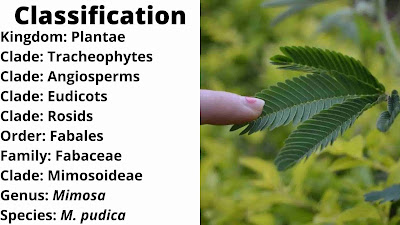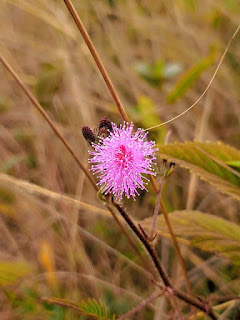Why touch me not plant closes?
Animals have tend self-defence, plants have also a tendency to self-defence. And today we will learn about such plant shameplant.
It is a sensitive plant and it has the highest sensitivity compared to other plants.
This plant is native to Brazil, The Caribbean, South and central America, Hawaii, Puerto Rico and then move to the Asia and many pacific island. In India and South Asia, it is also known as 'touch me not plant'.
Classification
Roots
Most of the Mimosa plants have poisonous roots. So when you use these roots for medicinal purposes first ask the experts.
Stems
Young Mimosa has erect stems that transform to 5-feet long creeping or trailing stems.
Leaves
The leaves of the plant are thin like tamarind leaves. Most of the mimosa species have bi-pinnate types of leaves.
Leaves have tiny hairs on the surface.
This plant folding its leaves when we touch the leaves of the plant. Its leaves cannot withstand the touch of anything.
The leaves of the mimosa pudica closes at night and reopen in the morning. Mimosa closes as soon as it touches the leaves, hence it is called 'touch me not plant'.
Flowers
Mimosa flowers are yellow, blue, or pink. In this plant flowering can last for about 1 to 2 days only.
Fruits
It consists of 2 to 8 pods, and each pod holds brown seeds.
Seeds
Mimosa Pudica seeds are brown, and it is 2mm in diameter, and the shape is spherical and round.
Now we will talk about the most asked question on quora, google, Bing, yahoo etc that Why touch me not plant closes ?
Why touch me not plant closes when anything touches?
The leaves of this plant contain particular types of cells. So that when anything touches the leaves, the potassium and chloride ions in these specific cells are released. And then the water pressure in the leaves increases. This causes the leaves of the shameplant to close. Now you understand that why touch me not plant closes?
Is it Poisonous?
No. It is non-poisonous plant for humans according to University of California, Safe and Poisonous Garden Plants.
Common Name of Mimosa pudica plant
‘Touch me not plant’ contains nitrogen fixation bacteria. So it is convert atmospheric nitrogen.
Shame plant has several natural predators, such as the spider mite and mimosa webworm.
Mimosa Pudica is invasive species.
Mimosa Pudica Medicinal Uses
- Mimosa leeches are very useful when coughing.
- Very useful for people who have a problem with piles.
- Very useful for people who have excessive bleeding.
- Useful for body muscles.
- This plant is helpful for remove goiter or tumors.
- This plant is also useful for people who have tonsils.
- It is useful for diabetes patients.
- This plant is beneficial when there are stones and especially when stones in the kidneys.
- Very useful when there is swelling or tumor in the body.
- It is handy for quick healing of wounds in the body.
- This herb is useful for people who have excessive urination.
- This plant has become very useful for the research of scientists.
Disadvantage
The main disadvantage is sometimes it is a source of trouble for farmers as it harms other plants in the field. So If the mimosa is in tree form, remove and destroy the trees by burning.
Care of Mimosa Pudica
Mimosa Pudica is an indoor or outdoor plant. You can grow anywhere, and you can also do propagation in this plant.
Where to Grow PlantConclusion
Mimosa Pudica is a fascinating plant. It is well known for the speciality of its leaves, and that's why this plant is favourite for children.
Suppose you are beginners for learning how to growing plant. Then shameplant is the best option to start to learn. Because in this plant no more maintenance.


